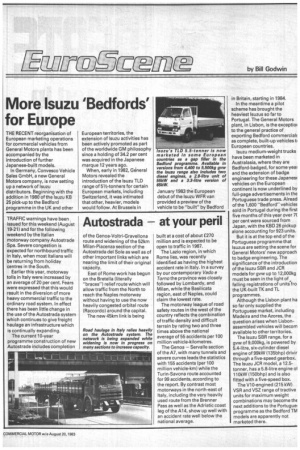Autostrada — at your peril
Page 51

If you've noticed an error in this article please click here to report it so we can fix it.
TRAFFIC warnings have been issued for this weekend (August 19-21) and for the following weekend by the Italian motorway company Autostrade Spa. Severe congestion is expected for northbound traffic in Italy, when most Italians will be returning from holiday centres in the South.
Earlier this year, motorway tolls in Italy were increased by an average of 20 per cent. Fears were expressed that this would result in the diversion of more heavy commercial traffic to the ordinary road system. In effect there has been little change in the use of the Autostrada system which continues to give freight haulage an infrastructure which is continually expanding.
The current 10-year programme construction of new Autostrade includes completion of the Genoa-Voltri-Gravellona route and widening of the 52km Milan-Piacenza section of the Autostrada del Sole as well as of other important links which are nearing the limit of their original capacity.
East of Rome work has begun on the Bretella (literally "braces") relief route which will allow traffic from the North to reach the Naples motorway without having to use the now heavily congested orbital route (Raccordo) around the capital.
The new 45km link is being built at a cost of about £270 million and is expected to be open to traffic in 1987.
The Lazio region, in which Rome lies, was recently identified as having the highest accident rate in Italy. In a survey by our contemporary Vado e Torno the province was closely followed by Lombardy, and Milan, while the Basilicata region, east of Naples, could claim the lowest rate.
The motorway league of road safety routes in the west of the country reflects the combination of traffic density and difficult terrain by rating two and three times above the national average of 55 accidents per 100 million vehicle-kilometres.
The Genoa — Servalle section of the A7, with many tunnels and severe curves leads the statistics with 155 accidents (per 100 million vehicle-km) while the Turin-Savona route accounted for 99 accidents, according to the report. By contrast most motorways in the north-east of Italy, including the very heavily used route from the Brenner Pass as well as the Adriatic coast leg of the A14, show up well with an accident rate well below the national average. in Britain, starting in 1984.
In the meantime a pilot scheme has brought the heaviest lsuzus so far to Portugal. The General Motors plant, in Lisbon, is the exceptior to the general practice of exporting Bedford commercialE as complete, built-up vehicles to European countries.
Isuzu medium-weight trucks have been marketed in Australasia, where they are Bedford-badged, for some year and the extension of badge engineering for these Japanes( vehicles on the European continent is now underlined by full-page advertisements in the Portuguese trade press. Alread of the 1,600 "Bedford" vehicle sold in Portugal during the first five months of this year over 7( per cent were sourced from Japan, with the KBD 26 pickup alone accounting for 923 units.
But it is at the top end of the Portuguese programme that Isuzus are setting the scene for General Motors' new approach to badge engineering. The significance of the introduction of the Isuzu SBR and JCR models for gvw up to 12,000kg must be seen in the light of falling registrations of units fro the UK-built TK and TL programmes.
Although the Lisbon plant ha so far only supplied the Portuguese market, including Madeira and the Azores, the question arises when Lisbonassem bled vehicles will becom available to other territories.
The Isuzu SBR range, for a gvw of 9,000kg, is powered by 5.4-litre, six-cylinder diesel engine of 99kW (135bhp) drivir through a five-speed gearbox. The Isuzu JCR model, a 12.5tonner, has a 5.8-litre engine ot 110kW (150bhp) and is also fitted with a five-speed box.
The V10-engined (215 kW) VSR and VSZ range of tractive units for maximum weight combinations may become the next additions to the Portugueo programme as the Bedford TM models are apparently not marketed there.
















































































